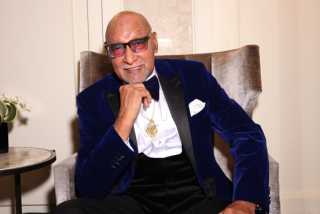Britt Woodman; Key L.A. Jazz Figure Played Trombone With Duke Ellington
- Share via
Britt Woodman, an important figure in the growth of the vibrant Los Angeles jazz scene in the 1930s and ‘40s, who became more widely known for his work as a trombonist with Duke Ellington’s Orchestra a decade later, has died.
Woodman died Friday at Robert F. Kennedy Medical Center in Hawthorne, according to his niece Beverly Woodman. He was 80 and had been suffering from severe respiratory problems.
In a career that encompassed one of jazz’s most unusual musical journeys, Woodman was active in the late ‘30s in such swing-oriented ensembles as the Les Hite Band.
He also played with the iconoclastic Boyd Raeburn Band of the mid-1940s before becoming a stalwart of the Duke Ellington Orchestra trombone sections in the 1950s. With Ellington, he was featured on numbers such as “Sonnet To Hank V” (from “Such Sweet Thunder”) and “Red Garter” (from “Toot Suite”).
Woodman’s versatility was such that he was comfortable in almost any setting. He recorded with Miles Davis; worked frequently with Charles Mingus (he is present on the classic recording “Mingus, Mingus, Mingus”); was a member of the brass section for John Coltrane’s “Complete Africa/Brass Sessions;” played in a long list of big bands, including the Lincoln Center Jazz Orchestra; and was active in the studios as well as in orchestra pits for theatrical musicals.
“Woodman was a consummate sideman, his professionalism apparent in his capacity to deal with such a wide array of musical demands,” said Don Heckman, The Times jazz writer. “But he was also a first-rate improviser, with a highly personal style.”
Born in Los Angeles on June 4, 1920, Woodman grew up in Watts as a member of a musical family. His father, a trombone player, believed that as the country entered the Depression, the best financial opportunities for his sons would come from making music.
Britt Woodman started playing piano at age 7. A short time later his father gave him a trombone, and then a saxophone and a clarinet. By the age of 15, Woodman was playing professionally in a group with two older brothers: the Woodman Brothers Biggest Little Band in the World.
They were so versatile and proficient as musicians that they often traded instruments in the middle of a set. It was not uncommon, for instance, for Britt Woodman to begin a set playing alto saxophone and then switch to trombone and finally to clarinet.
His older brother William--who had a professional career as a tenor saxophonist--also played clarinet and trumpet. A third brother, Coney, played piano and banjo. Their father managed the group, handled the bookings and arranged the music.
In the book “Central Avenue Sounds,” a history of the flourishing jazz scene near Central Avenue around World War II, William Woodman Jr. recalled that he and his brothers were well known among local musicians.
“We were recognized because we were the only musicians who doubled on three instruments,” he said. “You didn’t hear of anybody doubling on brass.”
After the band split up about five years later, Britt Woodman played in a variety of clubs on Central Avenue, including the legendary Club Alabam.
One of the clubs he worked in, he recalled in “Central Avenue Sounds,” was owned by the gangster Mickey Cohen. “Our payroll checks were signed by him,” Woodman said.
Woodman served in the Army during World War II and studied music on the GI Bill at Westlake College after his discharge. He joined Ellington a few years later and lived for the better part of his career in New York City. When Woodman married in the mid-1950s, Mingus was the best man. His wife, Clara, died in 1991. They had no children.
He was active professionally until 1997 when his health declined. He returned to Los Angeles earlier this year. Funeral arrangements were incomplete.
More to Read
The biggest entertainment stories
Get our big stories about Hollywood, film, television, music, arts, culture and more right in your inbox as soon as they publish.
You may occasionally receive promotional content from the Los Angeles Times.










